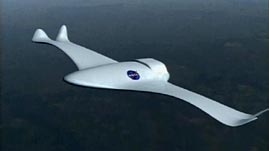Teachers' Domain - Digital Media for the Classroom and Professional Development
User: Preview

Source: NASA Center for Distance Learning
In the early 1900s, the Wright Brothers found inspiration for their first airplane in nature. Their "Flyer," which was modeled on a bird's flexible wing design, was steered and stabilized by pulleys and cables that twisted the wingtips. Despite its success, this control strategy quickly vanished from aviation. Instead, stiff wings capable of withstanding the greater forces associated with increased aircraft weights and flying speeds became the standard. In this video segment adapted from NASA, learn how designs found in nature have inspired today's aerospace engineers as they conceive the next-generation of flying machines.
Today, aerospace engineers are looking to successful designs in nature to help them build faster, safer, and more efficient flying machines. If their concepts prove successful, supersonic jets may one day rely on a subtle twisting of their wings for steering, and wing surfaces may mold themselves in flight from one shape into another, all thanks to substances known as "smart" materials that can shorten, elongate, or flex in response to electricity or light.
Although nearly all aircraft today have a fixed-wing structure, some can change their shape, or morph, in ways that enable them to achieve greater speed, control, or efficiency. The F-14 fighter jet can pivot its wings from an outstretched to a swept-back position. The recently decommissioned Concorde tilted its nose downward during subsonic flight. New morphing strategies strive for even more dramatic shape changes by means of simpler mechanisms that add little or no weight to the aircraft.
The airfoil shape of bird wings, which allows the difference in air pressure above and beneath the wings to generate a net lifting force, remains the subject of much aerospace engineering modeling. But in their efforts to increase the efficiency and maneuverability of aircraft, researchers are also looking at other evolutionary adaptations in birds. These adaptations include hollow bones that are lightweight but strong; lightweight feathers that catch the air; and wings that fold up when not in use.
One thing researchers have learned is that the thousands of feathers covering a bird's wings serve not only as insulating material and decoration, but also as airflow sensors. The feathers have specialized nerve endings that lift when the flow of air along them is disrupted, such as when a bird banks sharply, or when its gliding turns into a stall. Clearly, this automated response mechanism kicks in to assist in flight control.
Engineers are not just relying on birds as design models. Bats, fish, and insects such as bumblebees and dragonflies also provide lessons in flight that are worth mimicking. Future flight techniques based on any of these models may hold numerous benefits for both civilian and military aircraft, including reduced noise, increased fuel efficiency, a smoother ride, enhanced safety, better maneuverability, and the ability to land at lower speeds and on shorter runways.
 Loading Standards
Loading Standards Teachers' Domain is proud to be a Pathways portal to the National Science Digital Library.
Teachers' Domain is proud to be a Pathways portal to the National Science Digital Library.
